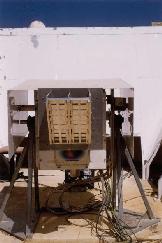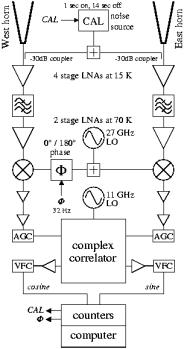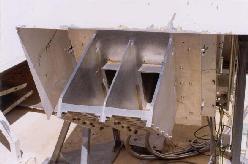The JBO-IAC 33GHz Interferometer. Brief Description
The instrument was constructed at JBO (Jodrell Bank Observatory, Manchester University) during the year 1994 following the same lines that the 5 GHz interferometer that the group has been operating for several years (Melhuish 1992). It was installed at Teide Observatory (Tenerife), at 2400 m above sea level.
The analyses of our previous data at 33 GHz (Davies et al. 1996) have demonstrated that the quality of the atmosphere at this site allows observations at this frequency. The aim of the project was to measure the CMB level of fluctuations in the range l=100-200. Higher resolutions are more easily obtainable with interferometry which also enables changes by changing the separation of the horns.
Another benefit, when compared to the beam-switching experiments, is a greater cancellation of atmospheric noise due to the closer separation of the fringes (Webster,1994). We chose a frequency of 33 GHz which lies between the two strong atmospheric lines at 22 and 57 GHz and where Galactic emission is much reduced.
The figure on the left presents an schematic diagram of the JB-IAC Interferometer at 33 GHz (a complete description of the instrumental setup and observing strategy can be found in Melhuish et al. 1998). The instrument has two horns East-West positioned in a single E-W baseline, with separation in the range 15-30 cm which corresponds to angular sensitivity to multipoles 100-200 respectively. The signals collected are passed through a series of amplifiers and mixers to produce two 4-7 GHz intermediate frequency signals. These are then fed into a complex correlator to produce DC outputs which represent the real and imaginary parts of the radiofrequency signal.
The operating frequency range is 31-34 GHz near a local minimum in the atmospheric emission. This high sensitivity is obtained by the use of cryogenically cooled, low noise, HEMT amplifiers, and a large ~3 GHz bandwidth. The sensitivity of the receiver noise is 200 µK in a 2 minute integration time. The low levels of precipitable water vapour (typically less than 2 mm) at Izaña Observatory, permit the collection of high quality data, limited by the receiver noise for over 80 per cent of the time.
The measured beam shape of the interferometer is described by a Gaussian of 2.25 degrees in right ascension and 1.0 degrees in declination, modulated by fringes with period of 3.48 and 1.72 degrees in right ascension for the low an high spacing mode respectively. This defines the range of sensitivity to the different multipoles of the CMB power spectrum in the range 106±19 and 208±18 respectively. In the third figure we show a detail of the horn-reflector antenna system, in the short spacing configuration.


